
Containerization is a system of intermodal freight transport using intermodal containers. The containers have standardized dimensions. They can be loaded and unloaded, stacked, transported efficiently over long distances, and transferred from one mode of transport to another—container ships, rail transport flatcars, and semi-trailer trucks—without being opened. The handling system is completely mechanized so that all handling is done with cranes and special forklift trucks. All containers are numbered and tracked using computerized systems.

A container ship is a cargo ship that carries all of its load in truck-size intermodal containers, in a technique called containerization. Container ships are a common means of commercial intermodal freight transport and now carry most seagoing non-bulk cargo.
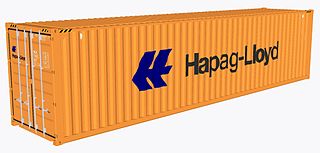
Hapag-Lloyd AG is a German international shipping and container transportation company. Hapag-Lloyd was formed in 1970 through a merger of Hamburg-American Line (HAPAG) and North German Lloyd.

The twenty-foot equivalent unit is an inexact unit of cargo capacity, often used for container ships and container ports. It is based on the volume of a 20-foot-long (6.1 m) intermodal container, a standard-sized metal box which can be easily transferred between different modes of transportation, such as ships, trains, and trucks.

Colombo Express is one of the largest container ships in the world. When launched in 2005, she was claimed by her owner to be the world's largest container ship, a title she held until Emma Mærsk was launched in 2006.

Yantian Express is a Hapag-Lloyd Hamburg Express class container ship, delivered in 2002. She was constructed by Hyundai Heavy Industries in Ulsan, South Korea, a measures 320 by 43 m, and delivered under the name Berlin Express but soon renamed Shanghai Express. Her capacity is 7,510 20ft containers and she carries this load at 22.5 knots.
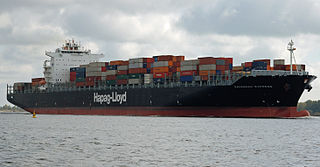
Savannah Express, is a container ship owned by the Norddeutsche Reederei H. Schuldt company out of Hamburg, Germany. She was completed in 2005. The ship is capable of transporting up to 8401 TEUs at any one time, making her at that time one of the largest container ships in the world. The deadweight tonnage (DWT) is 107,000 metric tons and the maximum speed of this ship is 25 knots. The ship is 332 metres (1,089 ft) long and has a beam of 43.2 metres (142 ft). The engines are capable of outputting 68,520 kilowatts of power.

SS Cleveland was a German transatlantic ocean liner that was launched in 1908 and scrapped in 1933. Cleveland was built for the Hamburg America Line (HAPAG) as a sister ship for Cincinnati.

Christensen Canadian African Lines (CCAL) was a Norwegian cargo shipping company that traded between Canada and Africa between 1948 and 2000.
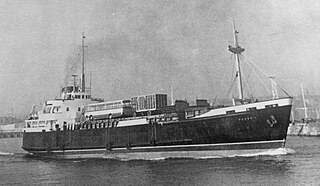
MV Peveril was a coastal cargo vessel operated by the Isle of Man Steam Packet Company. Peveril, the third ship in the Company's history to bear the name, was built by Ailsa Shipbuilding Company at Troon, Scotland, in 1964.

Kyoto Express is a container ship of the Colombo Express class of ships owned and operated by Hapag-Lloyd AG. Registered from Hamburg, Germany, the vessel has been in operation since 2005.

Tsingtao Express is owned by Hapag-Lloyd, one of the largest container ship companies in the world. The ship is registered in Hamburg, Germany.
SS Hertford was a refrigerated cargo steamship that was launched in Germany in 1917, seized by the United Kingdom in 1920 as World War I reparations, and sunk by a U-boat in 1942 with the loss of four members of her crew.
Tokio Express was a container ship, built and registered in Hamburg in 1973 for Hapag-Lloyd. In 1984 she was renamed Scandutch Edo before being acquired by Pol Gulf International in 1993 and restored to her original name. In 1997, she was acquired by Westwind International and in 1999, by Falani, before being broken up for scrap in 2000.

Hong Kong Express is a fully cellular container ship of the Hamburg Express Class owned and operated by the German shipping company Hapag Lloyd Container Linie.
ACX Crystal is a container ship built in South Korea in 2008. In June, 2017, the ship was damaged in a collision with USS Fitzgerald south of Yokosuka, Japan.

Admiral Karpfanger was a German four-masted barque that was a cargo ship and sail training ship. She was built near Bremerhaven in 1908 as l'Avenir, which was the name that she bore until 1937. She spent most of her career with the Association Maritime Belge, SA.
SS Santa Fé was a German refrigerated cargo steamship. She is now a Black Sea shipwreck and part of her cargo is of interest to marine archaeologists.
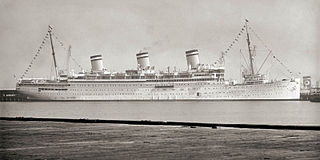
SS Reliance was one of a pair of a pair of transatlantic steam ocean liners that were launched in 1914 in Germany for the Hamburg America Line (HAPAG), sold to a Dutch shipping line in 1916, and seized by the United States as World War I reparations in 1922. United American Lines (UAL) operated her until 1926, when HAPAG bought her back.
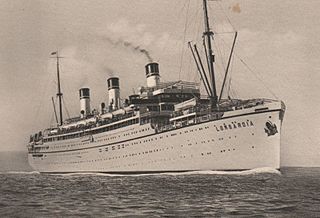
SS Lombardia was one of a pair of a pair of transatlantic steam ocean liners that were launched in 1914 in Germany for the Hamburg America Line (HAPAG), sold to a Dutch shipping line in 1916, and seized by the United States as World War I reparations in 1922. United American Lines (UAL) operated her until 1926, when HAPAG bought her back.
















